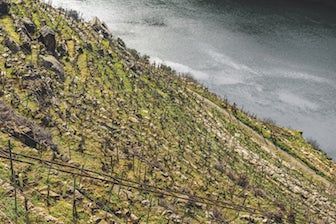
At home with the viñadores: A vivacious guide to Spain
An intriguing editorial decision has been made in preparing Luis Gutiérrez’s vivacious book for publication in English. Somebody at the publisher—or Gutiérrez himself—has chosen to render the original Spanish title Los Nuevos Viñadores not as (the admittedly altogether less mellifluous) “The New Winemakers” or (the very American) “New Vintners” but instead by using the French term “vignerons.” At the risk of reading too much into a single word, one might wonder on first picking up the book if there isn’t a subtext of cultural cringe here—a sense that the (Barcelona-based) publisher feels the Anglosphere is still under the sway of France when it comes to conceptions of what (or who or where) makes for fine wine. It’s not as if the publisher is even all that confident that prospective readers will be familiar with “vigneron,” adding, as they have, a dictionary definition as an addendum to Gutiérrez’s introduction. So, why not just stick with viñadores?
Having raced through its enjoyably chatty but detailed contents, however, another theory suggests itself: Maybe vigneron, a term favored by a certain kind of wine producer all over the world, just happens to be the mot juste for the kind of producer featured here; maybe this word has in fact broken free of its French origins to take on a boundary- crossing international connotation, even as the winemakers who so describe themselves take pride in making wines that are resolutely local.
Portraying uniqueness
In his tantalizingly brief introductory page, Gutiérrez describes his subjects as people who “travel the world, eat, drink, enjoy life, they taste different wines, they challenge what’s established, they push the limits, make mistakes, learn and improve […]. Their main aim in life is to portray the uniqueness of their vineyards, villages and landscapes through a bottle of wine.” These new vignerons, or viñadores—their wines “stripped of the excesses from the past, the superfluous layers that for a dark decade have hidden them behind over-ripeness, over-extraction, over-oaking, and over-pricing”— sound a lot like their counterparts in Swartland or the Santa Cruz Mountains. And seen in this light, Gutiérrez’s book can be viewed as the latest in a series that also includes Jon Bonné’s New California and Tim James’s Wines of the New South Africa.
As with those two excellent works, however, the joy of Gutiérrez’s book is in the way it captures the diverse approaches and produce that can emerge from the application of common philosophical first principles—and how dependent that diversity is on the traditions and terroir of the place where each vigneron has chosen to work. Indeed, not the least of the pleasures of The New Vignerons—you might even call it a public service—is the way it buries the rather monolithic view of Spain as a single land of endless plains of heat, dust, and passion that even the recent, cataclysmic events in Catalonia haven’t quite managed to shake entirely from popular perception.
Deep, humane portraits
In this project, Gutiérrez is aided enormously by his photographic compadre Estanis Núñez. Just flicking from Núñez’s beautifully reproduced shots of, say, Pedro Guímaro’s misty, cool, dramatically steep Mosel-like slate riverbank vineyard in Galicia’s Ribeira Sacra, to the gently sloping, limestone-pebble-flecked, Monastrell bush vine-dotted plains of José María Vicente’s Casa Castillo in Jumilla, offers a study in deep geographical contrast.
Núñez—a professional photographer specializing in portraits of rock stars as much as the world of food and wine in publications including Rolling Stone, El Mundo, and The World of Fine Wine, as well as being a long-term friend of the author—also provides unusually atmospheric shots of the various local dishes that Gutiérrez describes as part of his producer profiles. These foodie elements are more than mere interludes. Interesting and appetizing as it is to learn about the “pork culture” of Ribeira Sacra, the suckling lamb of Ribera del Duero, or the rice dishes of Valencia from an unashamed bon vivant, the real value of these sections is to situate the vignerons’ wines firmly in their local gastro-cultural context.
But it is, at all times, the vignerons who are the real stars of the story, for both photographer and writer. There are 19 in total, representing 14 producers (Tenerife’s Envinate has four equal partners, and Sara i René Viticultors of Priorat and Comando G both have two), each with its own detailed chapter. As English-language readers of his work as Spanish correspondent for jancisrobinson.com and, for the past few years, The Wine Advocate will know, Gutiérrez has a thoroughly endearing way of blending the untrammeled enthusiasm of the amateur (which, for the start of his wine-writing career, before he’d given up his day job, is precisely what he was) with the deep knowledge of the professional.
It’s a mix that translates well to a book based on, as Gutiérrez says, a personal selection of Spanish producers (and with which, incidentally, even for fans of such names as Recaredo or Juan Antonio Ponce, it’s hard to quibble). Gutiérrez’s admiration is always apparent, but it never tips over into fanboy-with-typewriter gushing. His affection brings depth and humanity to portraits of such diverse characters as the gentleman polymath Pablo Calatayud of Valencia’s Celler del Roure, the fine cider evangelist Iñaki Otegi of Malus Mama in the Basque Country, and the restless perfectionist Telmo Rodriguez of Rioja (and elsewhere), all the while imparting, without ever lapsing into sterile technicalities, a great deal about each individual’s winemaking techniques.
The book is also mercifully (and deliberately) free of tasting notes, though, somehow, in its deeply personal, digressive, occasionally eccentric, and sometimes haphazard style, it succeeds in a task with which more conventional wine books often fail, bringing you back to the thing the vignerons—or viñadores—really care about: their wines.
Published by Planeta Gastro; €32.95 / $60.35 / £47.81






